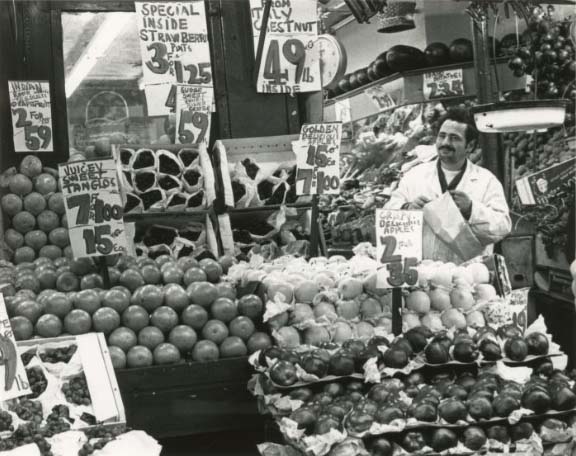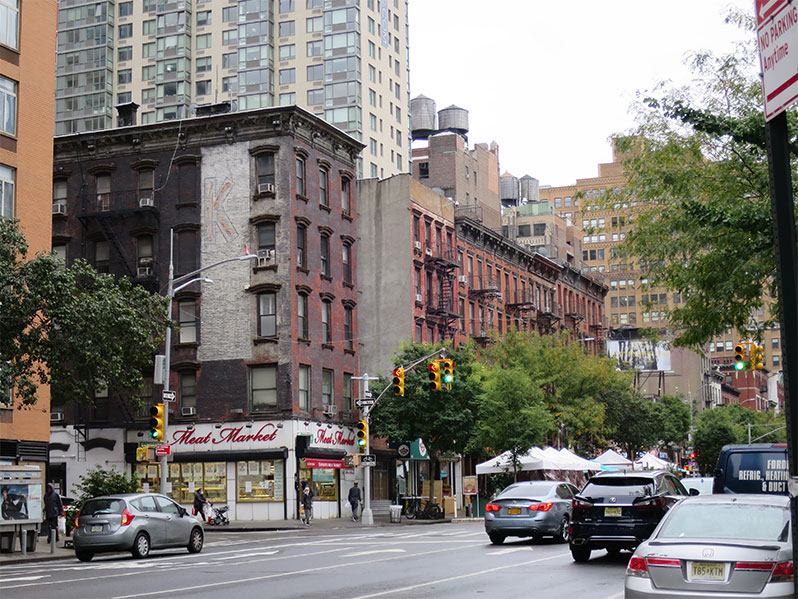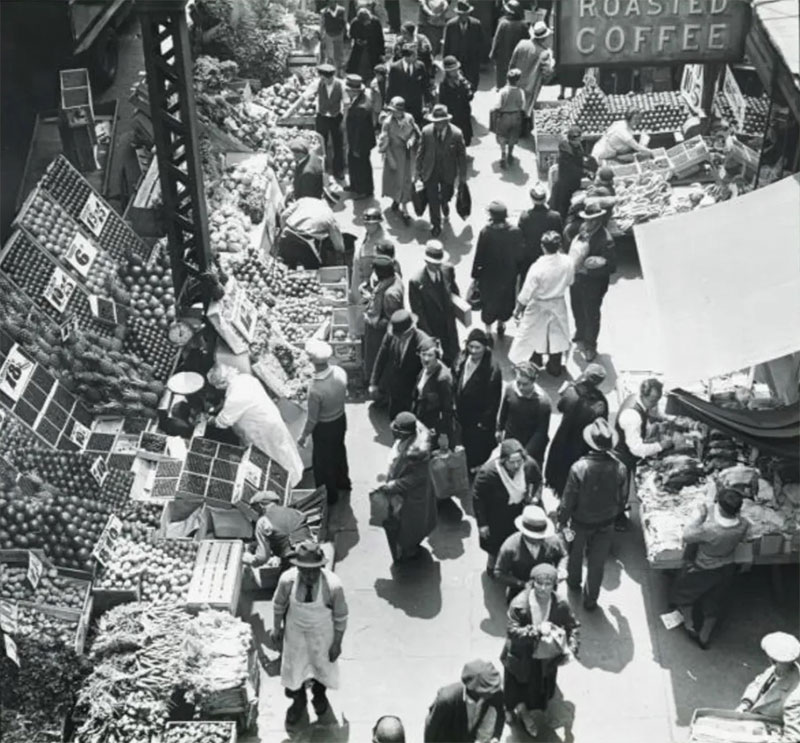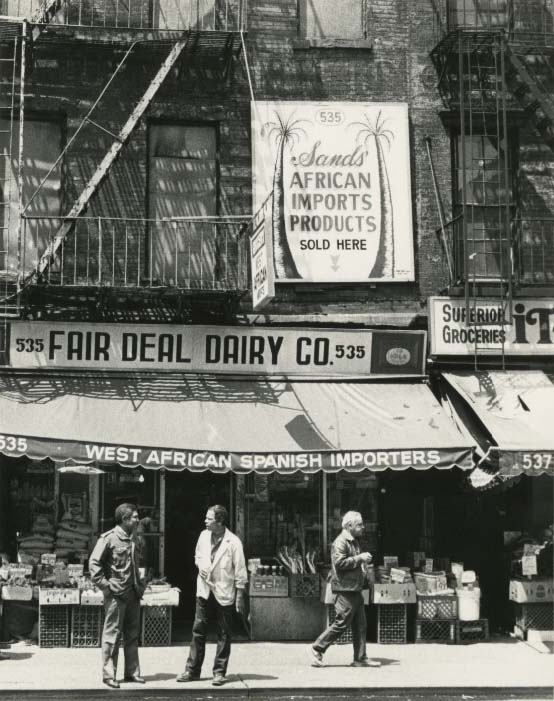Paddy's Market Historic District

Paddy's Market, a stretch of Ninth Avenue that was once one of the best-known pushcart markets in Manhattan, was originally established around 1885 by Irish and German immigrant peddlers who lined the avenue with their wares. The market was a central feature of the Hell's Kitchen neighborhood, supported and operated by those living in neighboring tenements, but also a destination within the greater New York City region. It lasted until 1938, when the city abolished the market in an effort to ease traffic congestion related to the newly constructed Lincoln Tunnel. In the decades after the market was closed, the name "Paddy's Market" came to refer to the stretch of international food stores and restaurants along Ninth Avenue in the area of the former market. Several legacy stores purveying food to the Clinton/Hell's Kitchen community remain to this day.

The Historic District includes nine block fronts on either side of Ninth Avenue between West 35th and West 40th Streets and portions of surrounding blocks. The District boundaries are inclusive of the Ninth Avenue corridor, primarily on the east side of the Avenue but also on the west side, as well as the intact collection of extant tenements and other buildings on the side streets, which are associated with the history of Paddy's Market. The District includes nearly 80 buildings, most of them mid-to-late nineteenth-century pre-law or old-law tenements. In many cases, their storefronts remain intact, even as they continue to house food stores and restaurants.

Today, Paddy's Market Historic District is nestled between the bustling Garment Center and Hudson Yards commercial districts, yet still maintains its 19th Century look and feel. Food markets and restaurants housed in residential tenements line 9th Avenue and serve the broader West Midtown community. Step back in time and take a self-guided tour through one of the most eclectic and historic food destinations in New York City, and meet today's merchants along the way.
Paddy's Market Self-Guided Tour
Historic Photos of Paddy's Market
Food Markets in New York City
.jpg)
New York City, like many other large cities around the world, has a long history of building and operating food markets. For decades, these public markets drew their main food supply from within a relatively small radius of miles from the city. However, as the city grew and the surrounding communities could no longer supply it, food began to be received from all parts of the United States and the industry transformed into a wholesale operation. Coming from longer distances, and subject to delays and damage, the perishable food did not always arrive in the city in good condition, or least in a condition that buyers had come to expect. So, commission merchants and wholesalers sought to save themselves and their clients from loss and sold the food for whatever they could get for it, primarily serving poorer areas of the city.
Prior to the 1880s, these pushcart peddlers were mostly kept on the move by restrictive laws that governed the amount of time they could spend in any one location. But, as the density of recent immigrants grew in certain districts—notably the Lower East and the Middle West sides—it became possible for groups of peddlers to support themselves in a specific location. Paddy's Market began on Ninth Avenue and 39th Street as early as 1885. Other early open-air pushcart markets included those in the Lower East Side, on Hester Street (1886), Grand Street (1893), Rivington Street (1898), Orchard Street (1898), and East Monroe Street (1901). As foreign immigration soared in the Lower East and the Middle West sides, the pushcart industry grew to match it.
.PNG)
In Hell's Kitchen, the pushcart market became a vital part of the economy, supporting an incredibly large, poor population. Census records from the early part of the twentieth century show that most residents of the district did not identify themselves as part of the market however, several were recorded as being "hucksters," owning pushcarts, or working in food stores. For example, the 1900 federal census shows that Antone Stinl, Vito Savino, and Ralph Stanio, Italian immigrants who immigrated in the late 1880s and lived at 545 Ninth Avenue, worked as vegetable peddlers. By 1940 it appears some peddlers were able to gain footholds in storefronts. For example, Rocco Palmadessa, an Italian fruit stand proprietor, who was reportedly a former Paddy's Market seller, owned and operated a fruit and vegetable store at 401 West 40th Street. His son, Willy Palmadessa, would go on to operate the Friendly Farmer, a fruit and vegetable stand, on the sidewalks in front of 541-547 Ninth Avenue until 1995.
For decades, these pushcart markets operated in a gray area of the law; they were technically illegal but tolerated by the city as a necessary evil. A survey in 1915 identified the variety of markets that existed in New York City, including: "nine important marts for the sale of produce" (among the better remembered today being Washington Market, Jefferson Market, and Gansevoort Market) operated by the city; several "private market enterprises"; and "...a number of push-cart markets, or, as they are termed, "illegal" ones, where the push-cart men have established voluntary centres [sic], under police supervision, but pay no revenue for their space for the most part in the open streets."
.png)
In 1917, a Department of Markets was created to operate and supervise the city's wholesale markets (Bronx Market, Brooklyn's Wallabout Market, and in Manhattan, the West Washington, Gansevoort Meat and Fulton Fish Markets). By 1921, the Department of Markets also regulated the open-air pushcart markets, actively recognizing and licensing the peddlers. Eventually the Department would come to also inspect weights and measures, track food entering the city, oversee slaughtering facilities, and consumer education. It is possible that the increasing professionalization of the pushcart markets also led to more peddlers identifying themselves as such in census records. For example, in 1930, 547 Ninth Avenue was the home to John Rangaves, a street huckster of Greek origin. Although the building was located well within Paddy's Market, no previous resident had identified themselves as part of the market before then.

In 1934, Fiorella LaGuardia was elected as mayor of New York City, running primarily on a progressive reform platform. LaGuardia made the removal of the pushcarts a priority and, with the assistance of federal funds through the Public Works Administration, constructed nine enclosed public markets in areas that had previously had open-air markets. Ultimately, the new markets only contained a fraction of the pushcart peddlers that were displaced. Although the public markets were popular, by World War II cars, suburbanization, and home refrigeration did much to change shopping and food provisioning habits. Through the 1950s and 1960s development pressure led to the sale of some markets and others were shut down and either re-purposed or demolished. Of the original nine, only three survive, including Arthur Avenue in the Bronx, Moore Street in Brooklyn, and Park Avenue in Manhattan.
The Department of Markets was eventually dismantled in the late 1960s. Restaurant owners, hoteliers, grocers and pushcart vendors continued to buy from "truck" markets held in the parking lots of the Brooklyn and Bronx Terminal Markets, but as suburbanization eclipsed farming, those closed too. However, as Babette Audant explained in Savoring Gotham: A Food Lover's Companion to New York City, the movement for fresh produce was revived with the first Greenmarket, held in Union Square in 1976, which led to several decades of growth for public markets in various forms.
What is the National Register?
Paddy's Market Historic District is listed on the State and National Register of Historic Places. Established by the National Historic Preservation Act of 1966, the National Register of Historic Places is the official list of historic properties that have been recognized as significant in American history, architecture, archaeology, engineering, or culture.
Historic District Benefits
Tax Incentives: Historic Preservation Tax Credits
Access to New York City, State and Federal Grants & Loans
Identity & Branding for Economic Development
National Register Historic Districts (NR) do not restrict what private property owners can do with their properties. National Register listing also does not trigger local New York City Landmark designation. However, listing on the NR does make privately owned properties eligible for federal and state Historic Preservation Tax Credits and/or below market loans for renovation. Properties owned by non-profits or municipalities can be eligible for grants. It also creates formal identity and branding for economic development.
For answers to frequently asked questions to owning a contributing property in a National Register historic district, visit the links below:
History of Designation
Clinton Housing Development Company (CHDC), a not-for-profit community-based organization dedicated to building and preserving affordable housing in Clinton/Hell's Kitchen, proposed to nominate Paddy's Market, a stretch of Ninth Avenue that was once one of the best-known pushcart markets in Manhattan, to be listed as a historic district on the State and National Register of Historic Places in 2020-2021. The National Park Service designated the District in April 2022.
A presentation was given in December 2020 to Manhattan Community Board 4, that meeting recording on YouTube can be accessed at: shorturl.at/sAIQX. At the public meetings on October 27th and November 17th, 2021, presentations were made by CHDC in partnership with Manhattan Community Board 4 and the Hudson Yards Hell's Kitchen Business Improvement District on the history of the district, the boundaries, and the various benefits related to being listed on the National Register. You can view the presentation deck from October 27th, 2021 here.
On February 10th, 2022, CHDC and the New York State Historic Preservation Office hosted another public meeting to answer questions. The historic district was then considered by the New York State Board for Historic Preservation at its meeting on March 10, 2022, for nomination to the National and State Registers of Historic Places. The District was designated by the National Park Service on April 28, 2022.







.jpg)
.png)
